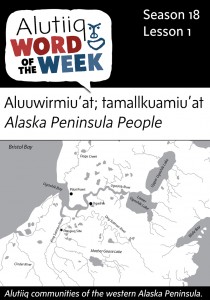 Aluuwirmiu’at; tamallkuamiu’at – Alaska Peninsula People
Aluuwirmiu’at; tamallkuamiu’at – Alaska Peninsula People
Aluuwirmiu’at yaqsisinartut. – People of the Alaska Peninsula are far away.
The Alaska Peninsula is a cultural crossroads, a place where the peoples of the Bering Sea, Aleutian Islands, and Gulf of Alaska have long interacted. Archaeological data suggest that Alutiiq people moved west across the peninsula about 750 years ago, settling the low, wet, tundra floodplain of the northwestern peninsula. One of the largest Alutiiq communities in this area was Ugashik.
Ugashik village lies on the bank of the Ugashik River, about sixteen miles above Ugashik Bay. Early travel accounts suggest that people in Ugashik spoke a unique dialect of Alutiiq that included many elements of the Yup’ik language spoken to the north. This unique mix of the Alutiiq and Yup’ik languages likely reflects the mobility of Alaska Peninsula peoples and their contact with neighboring groups. Ugashik residents harvested widely from Bristol Bay waters, peninsula environments, and the Pacific coast. In the late nineteenth century, Ugashik families traded in Nushagak to the northwest but also traveled across the Alaska Peninsula to trade at Katmai.
Ugashik village flourished as a center of trapping activity in the Russian era. However, as commercial canneries developed in Ugashik Bay, many residents moved to participate in wage labor, establishing the adjacent coastal village of Agishik, or Pilot Point. Similarly, in the 1890s, a substantial number of villagers moved to the Pacific coast to the new community of Kanatak. This settlement lay in Portage Bay, at the end of the portage trail at the head of the Ugashik River. In 1918, many remaining villagers died from a devastating flu pandemic. Ugashik never regained a substantial population.
